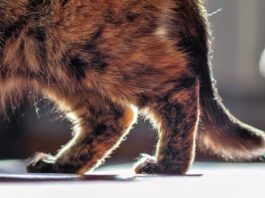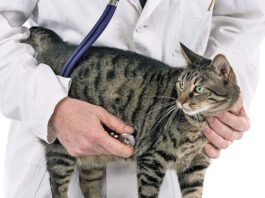International Experts Identify Signs of Pain
These are among key 25 signs of pain in cats identified in research at the University of Lincoln in the U.K. Dr. Isabella Merola and Daniel Mills, Professor of Veterinary Behavioral Medicine, surveyed international academics and practitioners with specialties in internal medicine, anesthesiology, oncology, dentistry, behavior, dermatology, ophthalmology and neurology. They say in PLOS One that the resulting list could lead to faster diagnoses and ultimately reduce suffering.
Your Cat Can Help Genetic Research
Diseases such as inflammatory bowel disease, hypertrophic cardiomyopathy and diabetes mellitus may have a genetic basis, and by comparing DNA from affected and healthy cats, the Biobank hopes to locate the responsible genes. Its work could lead to identifying cats at risk of disease and aid in developing more effective treatments.
In the News: Kitten Kindergartens Trending at Shelters
A growing number of animal shelters and veterinary clinics around the country are offering kitten kindergartens in an innovative way to socialize kittens and increase their adoptability. Australian veterinary behaviorist Dr. Kersti Seksel developed the program about a decade ago.
How Tuxedo Cats Got Their Coats
The existing theory about the origin of piebald patches, the white patterns in the coats of black and white cats, was that pigment cells moved too slowly in the embryo to reach all parts of the body. Obesity continues to be a health problem in pets, judging by a recent report from Nationwide. The U.S. Postal Service will issue booklets of forever stamps offering a choice of 20 different pets sometime this year.
Healthcare Costs, Veterinary Practices, Most Popular Cat Names
Studies on the benefits of pet ownership usually focus on the physical, social and psychological. Now a research group has calculated its economic impact. Among other goals, Cat Friendly Practices seek to educate clinics about feline patients unique needs and to decrease stress by handling cats in a gentle, empathetic and caring manner. In searching its database of more than a half million insured pets, Nationwide found that the most popular name for cats in 2015 was the same as the previous year.
From Barn to Bedroom; Sleeping With Pets
An article in the February issue on alternatives to relinquishing pets to shelters featured a dashing photo of Rascal, a feral cat who was neutered, vaccinated and adopted to work as a Rodent Ranger. A small study by the Mayo Clinic Center for Sleep Medicine in Scottsdale, Ariz., suggests that owners sleeping with their pets can experience positive effects. Replies to a questionnaire from 150 consecutive patients found that nearly half had pets; 41 percent had several.
Prehistoric Cats and A Cat Treat Recall
A team of scientists analyzing more than 2,000 fossils has made a surprising discovery, one they describe as contrary to current expectation. More than the effect of physical size and climate change, they found evidence indicating that early members of the cat family, arriving in North America from Asia, contributed to the extinction of 40 ancient dog species.
Free Reign of the House and Stem Cell Research
A survey of more than 10,000 pet owners in 11 countries - 3,100 of them in the U.S. - has found that U.S. owners are the most passionate about their cats. In addition to the U.S., the renovation and design firm Houzz asked owners about pets in the home in Canada, France, Italy, Spain, Sweden, Denmark, Russia, Germany, Australia and Japan. Veterinarians frequently prescribe therapeutic diets and daily medication for cats with chronic enteropathy, a condition characterized by excessive loss of plasma proteins into the gastrointestinal tract. However, the regimen can have side effects, and some owners have difficulty complying with it.
Cats ARE More Independent Than Dogs
We followed a small study that assessed the bond between children or pet dogs and their caregivers when theyre in potentially threatening or unfamiliar environments. The researchers observed the relationship between 20 cats and their owners with the cats in a new environment with their owner, with a stranger and on their own. They assessed the amount of contact the cats sought, their level of passive behavior and signs of distress when the owner was absent.
Stray Cats Outnumber People in Niagara
Niagara County SPCA in upstate New York calls itself the little shelter that could. It has a small staff of 19, a surgical trailer for sterilizations and a big population problem. Despite working with rescue groups and community cat caretakers, Executive Director Amy Lewis told WGRZ-TV in Buffalo that the city has 60,000 stray and feral cats compared to 50,000 people. As long as theyre not spayed or neutered, the number of homeless cats will keep increasing, she says. A lot of people dont spay and neuter - theres not low-cost, accessible spay-neuter programs for them. We do have one at the shelter, but we dont have the resources to accommodate large numbers of animals. The no-kill shelter sterilizes 40 to 50 cats a week but needs an in-house surgical suite to do more. Its board hopes to expand the facility or build a new one.
Short Takes: November 2015
Cats have long endured the reputation for being fussy eaters. Weve known for a decade that, with some exceptions, most cats lack the taste receptor gene for sweets. Now a study suggests that they may have a legitimate reason for avoiding another flavor.
Short Takes: October 2015
Students and volunteer citizen scientists, using motion-sensitive cameras at more than 2,100 sites in six Eastern states and the city of Raleigh, N.C., collected millions of images of domestic cats roaming outdoors at night. The result of North Carolina States exhaustive analysis of the images showed that the cats avoided parks and protected areas frequented by coyotes. Instead, they remained in residential areas, small urban forests and city trails.














